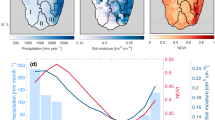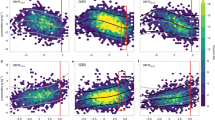Abstract
Anthropogenic warming is anticipated to increase soil moisture drought in the future. However, projections are accompanied by large uncertainty due to varying estimates of future warming. Here, using an ensemble of hydrological and land-surface models, forced with bias-corrected downscaled general circulation model output, we estimate the impacts of 1–3 K global mean temperature increases on soil moisture droughts in Europe. Compared to the 1.5 K Paris target, an increase of 3 K—which represents current projected temperature change—is found to increase drought area by 40% (±24%), affecting up to 42% (±22%) more of the population. Furthermore, an event similar to the 2003 drought is shown to become twice as frequent; thus, due to their increased occurrence, events of this magnitude will no longer be classified as extreme. In the absence of effective mitigation, Europe will therefore face unprecedented increases in soil moisture drought, presenting new challenges for adaptation across the continent.
This is a preview of subscription content, access via your institution
Access options
Access Nature and 54 other Nature Portfolio journals
Get Nature+, our best-value online-access subscription
$29.99 / 30 days
cancel any time
Subscribe to this journal
Receive 12 print issues and online access
$209.00 per year
only $17.42 per issue
Buy this article
- Purchase on Springer Link
- Instant access to full article PDF
Prices may be subject to local taxes which are calculated during checkout




Similar content being viewed by others
References
Dai, A., Trenberth, K. & Qian, T. A global dataset of Palmer Drought Severity Index for 1870–2002: Relationship with soil moisture and effects of surface warming. J. Hydrometeorol. 5, 1117–1130 (2004).
Greve, P., Gudmundsson, L. & Seneviratne, S. I. Regional scaling of annual mean precipitation and water availability with global temperature change. Earth Syst. Dynam. 9, 227–240 (2018).
Hirschi, M. et al. Observational evidence for soil-moisture impact on hot extremes in southeastern Europe. Nat. Geosci. 4, 17–21 (2010).
Dai, A. Increasing drought under global warming in observations and models. Nat. Clim. Change 3, 52–58 (2013).
Seneviratne, S. I. et al. Impact of soil moisture-climate feedbacks on CMIP5 projections: First results from the GLACE-CMIP5 experiment. Geophys. Res. Lett. 40, 5212–5217 (2013).
Trenberth, K. E. et al. Global warming and changes in drought. Nat. Clim. Change 4, 17–22 (2014).
Huang, J., Yu, H., Guan, X., Wang, G. & Guo, R. Accelerated dryland expansion underclimate change. Nat. Clim. Change 316, 847–171 (2015).
Berg, A., Sheffield, J. & Milly, P. C. D. Divergent surface and total soil moisture projections under global warming. Geophys. Res. Lett. 44, 236–244 (2017).
Cook, B. I., Ault, T. R. & Smerdon, J. E. Unprecedented 21st century drought risk in the American Southwest and Central Plains. Sci. Adv. 1, e1400082–e1400082 (2015).
UNFCCC Adoption of the Paris Agreement, Proposal by the President Report No. FCCC/CP/2015/L.9 (United Nations, 2015).
Raftery, A. E., Zimmer, A., Frierson, D. M. W., Startz, R. & Liu, P. Less than 2°C warming by 2100 unlikely. Nat. Clim. Change 109, 13915–13917 (2017).
Collins, M. et al. Quantifying future climate change. Nat. Clim. Change 2, 403–409 (2012).
Prudhomme, C. et al. Hydrological droughts in the 21st century, hotspots and uncertainties from a global multimodel ensemble experiment. Proc. Natl Acad. Sci. USA 111, 3262–3267 (2014).
Wanders, N., Wada, Y. & Van Lanen, H. A. J. Global hydrological droughts in the 21st century under a changing hydrological regime. Earth Syst. Dynam. 6, 1–15 (2015).
James, R., Washington, R., Schleussner, C.-F., Rogelj, J. & Conway, D. Characterizing half-a-degree difference: a review of methods for identifying regional climate responses to global warming targets. WIREs Clim. Change 8, 1–23 (2017).
Wilhite, D. Drought: A Global Assessment Vol., I. 3–18 (Routledge, London, 2000).
Moore, F. C. & Lobell, D. B. Adaptation potential of European agriculture in response to climate change. Nat. Clim. Change 4, 610–614 (2014).
Van Lanen, H. A. et al. Hydrology needed to manage droughts: the 2015 European case. Hydrol. Process. 30, 3097–3104 (2016).
Ciais, P. et al. Europe-wide reduction in primary productivity caused by the heat and drought in 2003. Nature 437, 529–533 (2005).
Samaniego, L., Kumar, R. & Zink, M. Implications of parameter uncertainty on soil moisture drought analysis in Germany. J. Hydrometeorol. 14, 47–68 (2013).
Samaniego, L. et al. Propagation of forcing and model uncertainties on to hydrological drought characteristics in a multi-model century-long experiment in large river basins. Climatic Change 141, 435–449 (2016).
Lehner, F. et al. Projected drought risk in 1.5°C and 2°C warmer climates. Geophys. Res. Lett. 44, 7419–7428 (2017).
Sheffield, J., Wood, E. F. & Roderick, M. L. Little change in global drought over the past 60 years. Nature 491, 435–438 (2012).
Warszawski, L. et al. The Inter-Sectoral Impact Model Intercomparison Project (ISI–MIP): Project framework. Proc. Natl Acad. Sci. USA 111, 3228–3232 (2014).
Samaniego, L. EDgE Model Chain and Development of Sectoral Climate Impact Indicators (Copernicus Climate Change Service, 2017); http://edge.climate.copernicus.eu
Kovats, R. et al. in Climate Change 2014: Impacts, Adaptation and Vulnerability (eds Barros, V. et al.) 1267–1326 (Cambridge Univ. Press, Cambridge, 2011).
Metzger, M. J., Bunce, R. G. H., Jongman, R. H. G., Mücher, C. A. & Watkins, J. W. A climatic stratification of the environment of Europe. Glob. Ecol. Biogeogr. 14, 549–563 (2005).
Rötter, R. P., Carter, T. R., Olesen, J. E. & Porter, J. R. Crop–climate models need an overhaul. Nat. Clim. Change 1, 175–177 (2011).
Guiot, J. & Cramer, W. Climate change: The 2015 Paris Agreement thresholds and Mediterranean basin ecosystems. Science 354, 465–468 (2016).
Seneviratne, S. I., Donat, M. G., Pitman, A. J., Knutti, R. & Wilby, R. L. Allowable CO2 emissions based on regional and impact-related climate targets. Nature 529, 477–483 (2016).
Robine, J.-M.et al. Death toll exceeded 70,000 in Europe during the summer of 2003. C. R. Biol. 331, 171–178 2008).
Wilbanks, T. et al. in Climate Change 2007: Impacts, Adaptation and Vulnerability (eds Parry, M. L. et al.) 357–390 (IPCC, Cambridge Univ. Press, 2007).
Hempel, S., Frieler, K., Warszawski, L., Schewe, J. & Piontek, F. A trend-preserving bias correction — the ISI-MIP approach. Earth Syst. Dynam. 4, 219–236 (2013).
McSweeney, C. F. & Jones, R. G. How representative is the spread of climate projections from the 5 CMIP5 GCMs used in ISI-MIP? Clim. Serv. 1, 24–29 (2016).
Samaniego, L., Kumar, R. & Attinger, S. Multiscale parameter regionalization of a grid-based hydrologic model at the mesoscale. Water Resour. Res. 46, W05523 (2010).
Kumar, R., Samaniego, L. & Attinger, S. Implications of distributed hydrologic model parameterization on water fluxes at multiple scales and locations. Water Resour. Res. 49, 360–379 (2013).
Sutanudjaja, E. H. et al. PCR-GLOBWB 2: a 5 arc-minute global hydrological and water resources model. Geosci. Model Dev. Discuss. 2017, 1–41 (2017).
Niu, G.-Y. et al. The community Noah land surface model with multiparameterization options (Noah-MP): 1. Model description and evaluation with local-scale measurements. J. Geophys. Res. 116, D12109 (2011).
Liang, X., Lettenmaier, D., Wood, E. & Burges, S. A simple hydrologically based model of land-surface water and energy fluxes for general-circulation models. J. Geophys. Res. Atmos. 99, 14415–14428 (1994).
Haylock, M. R. et al. A European daily high-resolution gridded data set of surface temperature and precipitation for 1950–2006. J. Geophys. Res. 113, D20119 (2008).
Rakovec, O. et al. Multiscale and multivariate evaluation of water fluxes and states over European river basins. J. Hydrometeorol. 17, 287–307 (2016).
Cuntz, M. et al. The impact of standard and hard-coded parameters on the hydrologic fluxes in the Noah-MP land surface model. J. Geophys. Res. Atmos. 121, 10676–10700 (2016).
Vautard, R. et al. The European climate under a 2 degrees C global warming. Environ. Res. Lett. 9, 034006 (2014).
Hawkins, E. et al. Estimating changes in global temperature since the preindustrial period. Bull. Am. Meteorol. Soc. 98, 1841–1856 (2017).
Palmer, W. C. Meteorological Drought Research Paper 45 (Office of Climatology, Weather Bureau, 1965).
Wells, N., Goddard, S. & Hayes, M. J. A self-calibrating Palmer Drought Severity Index. J. Clim. 17, 2335–2351 (2004).
Hargreaves, G. H. & Samani, Z. A. Reference crop evapotranspiration from temperature. Appl. Eng. Agric. 1, 96–99 (1985).
Acknowledgements
This study was partially performed under a contract for the Copernicus Climate Change Service (edge.climate.copernicus.eu). ECMWF implements this service and the Copernicus Atmosphere Monitoring Service on behalf of the European Commission. This study has been mainly funded within the scope of the HOKLIM project (www.ufz.de/hoklim) by the German Ministry for Education and Research (grant number 01LS1611A). We would like to thank P. Greve for providing data included in Supplementary Fig. 4. We acknowledge the funding from NWO Rubicon 825.15.003. We acknowledge the E-OBS dataset from the EU FP6 project ENSEMBLES (http://ensembles-eu.metoffice.com) and the data providers in the ECA&D project (http://www.ecad.eu). We would like to thank people from various organizations and projects for kindly providing us with the data that were used in this study, which includes ISI-MIP, JRC, NASA, GRDC, BGR and ISRIC. This study was carried out within the Helmholtz-Association climate initiative REKLIM (www.reklim.de).
Author information
Authors and Affiliations
Contributions
L.S. and S.T. designed the study and wrote the manuscript. S.T., R.K., N.W. and M.P. conducted the model runs. O.R. and M.Z. conducted analysis of the data. All authors contributed to interpreting results.
Corresponding author
Ethics declarations
Competing interests
The authors declare no competing interests.
Additional information
Publisher’s note: Springer Nature remains neutral with regard to jurisdictional claims in published maps and institutional affiliations.
Supplementary information
Supplementary Information
Supplementary Figures 1–9
Rights and permissions
About this article
Cite this article
Samaniego, L., Thober, S., Kumar, R. et al. Anthropogenic warming exacerbates European soil moisture droughts. Nature Clim Change 8, 421–426 (2018). https://doi.org/10.1038/s41558-018-0138-5
Received:
Accepted:
Published:
Issue Date:
DOI: https://doi.org/10.1038/s41558-018-0138-5
This article is cited by
-
Assessment of urban greenhouse gas emissions towards reduction planning and low-carbon city: a case study of Montreal, Canada
Environmental Systems Research (2024)
-
Evolution of drought characteristics and propagation from meteorological to agricultural drought under the influences of climate change and human activities
Environmental Science and Pollution Research (2024)
-
Was the 2022 drought in the Yangtze River Basin, China more severe than other typical drought events by considering the natural characteristics and the actual impacts?
Theoretical and Applied Climatology (2024)
-
The effects of multiple environmental factors on global carbon allocation
Ecological Processes (2023)
-
Perspectives of lignite post-mining landscapes under changing environmental conditions: what can we learn from a comparison between the Rhenish and Lusatian region in Germany?
Environmental Sciences Europe (2023)



